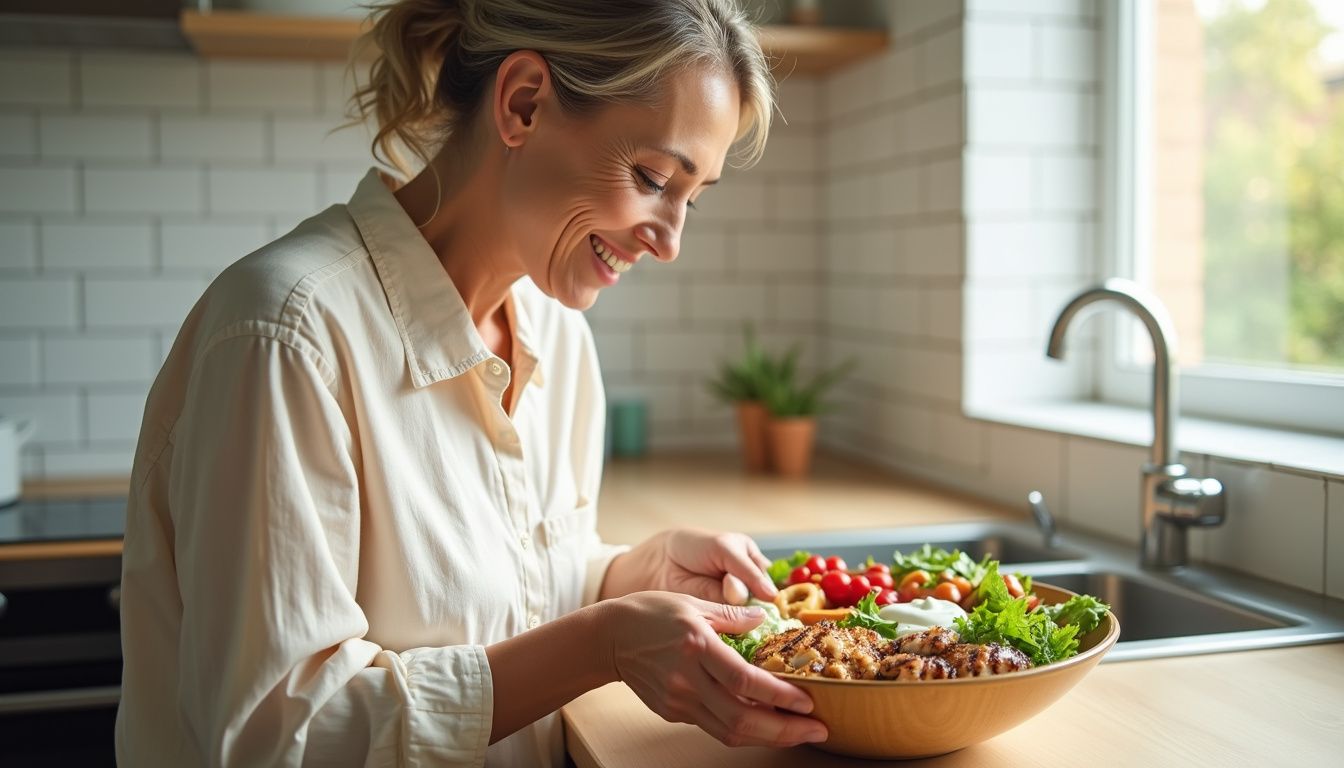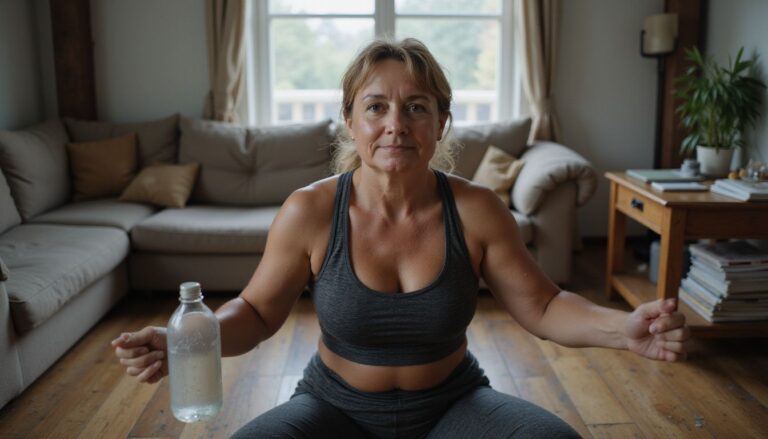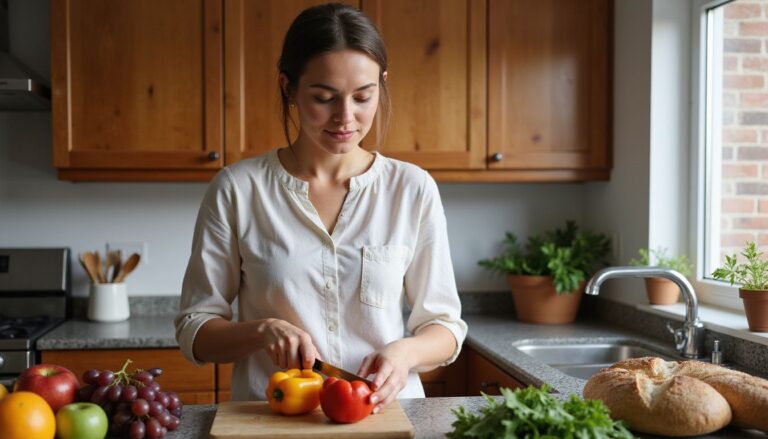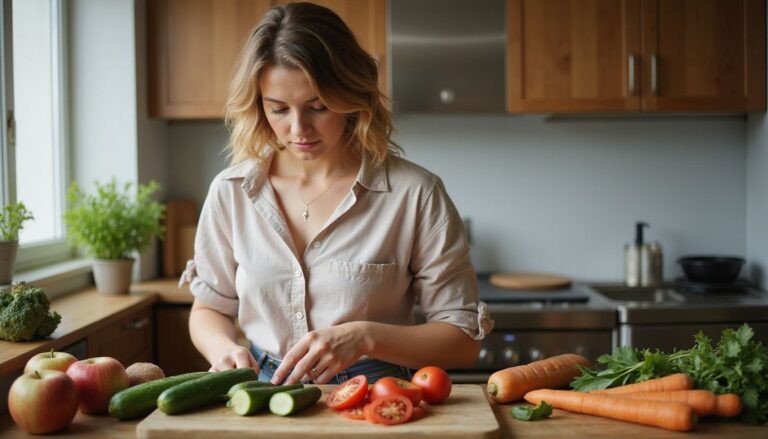Delicious High Protein Low Fat Recipes For Your Healthy Diet
Our Nutrition Assistant AI Suite will transform your body. You will lose fat, get toned, and build muscle. Gain confidence and optimal health.
If you want meals that help with weight loss and still taste great, you are not alone. A high-protein, low-fat approach can support your goals by giving you enough protein while keeping fat and calories in check.
This guide shows simple ways to eat more lean protein, avoid excess saturated fat, and feel full longer. You will use real foods like chicken breast, Greek yogurt, tofu, beans, and fish that fit a healthy diet.
Start reading for practical ideas you can cook tonight.
Key Takeaways
- High-protein, low-fat plans can support weight control and muscle health. A common target is at least 1 gram of protein per kilogram of body weight.
- Lean foods like skinless chicken breast, white fish, tofu, and beans keep fat lower while offering about 20 to 30 grams of protein per serving.
- Grilling, baking, steaming, air frying, and using nonstick spray reduce saturated fats better than frying or using butter and cream sauces.
- Plant-based dishes with lentils and chickpeas deliver solid protein with little fat plus fiber that keeps you full.
- The Dietary Guidelines for Americans, 2020 to 2025, encourage balanced plates with lean proteins for heart health and weight management.^1
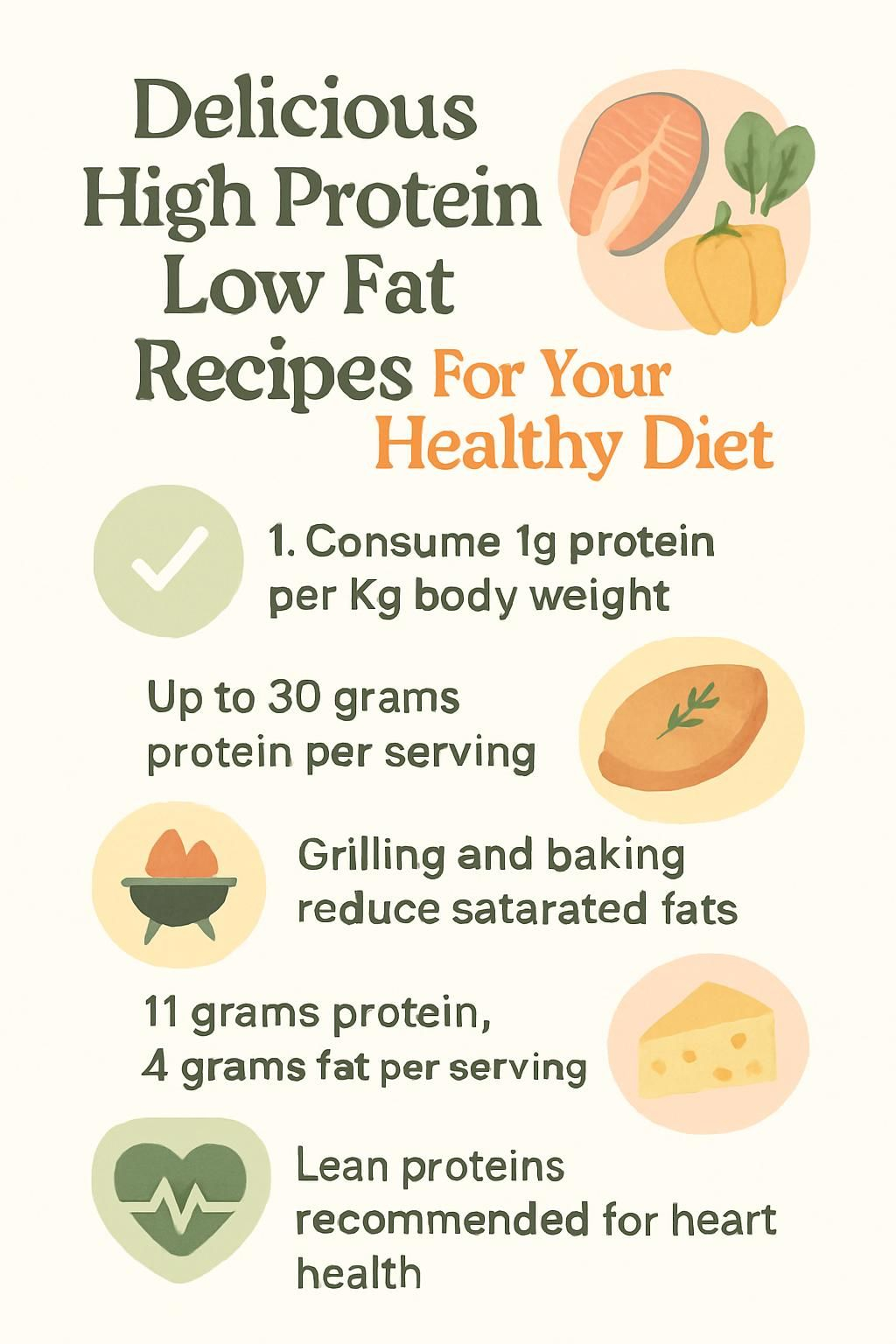
Benefits of High-Protein, Low-Fat Diets
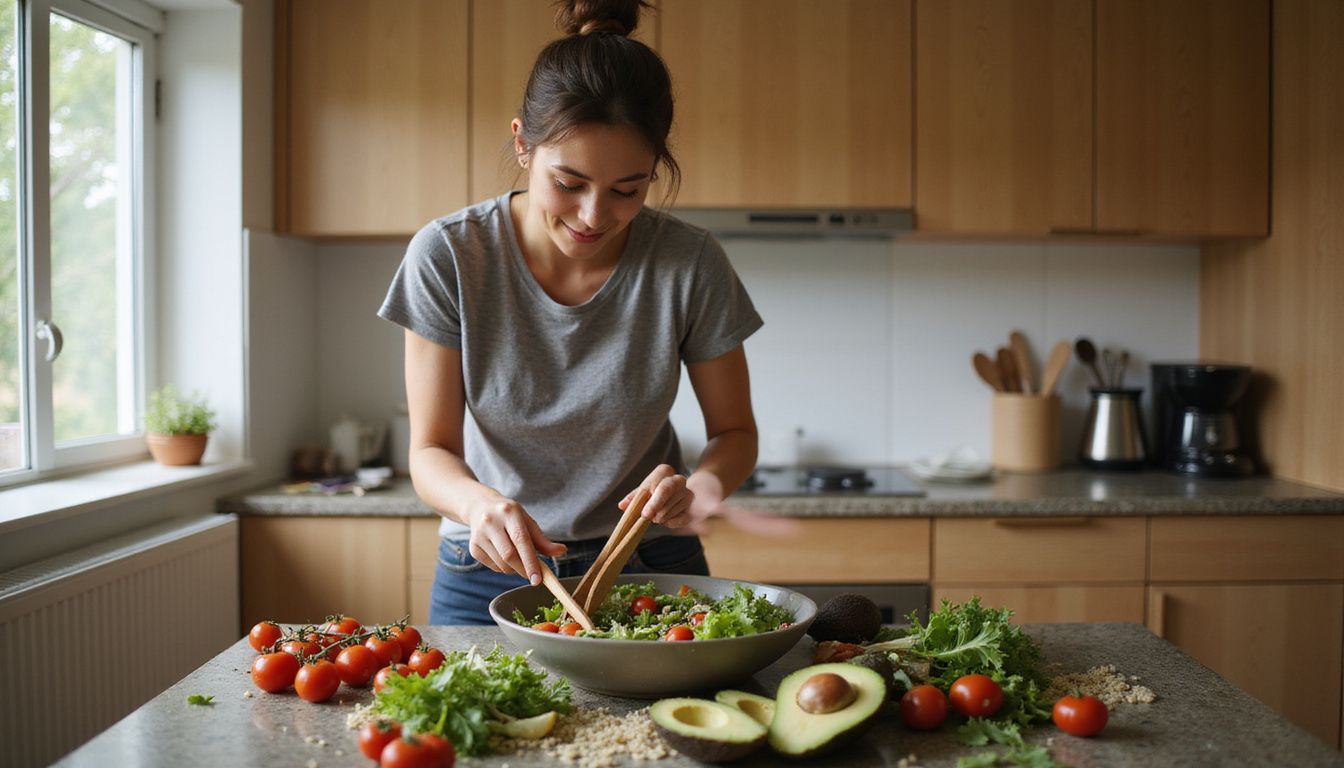
A high-protein, low-fat diet can make weight control simpler and support heart health. Lean protein helps protect muscle while you cut calories from fat.
What are the health benefits of high-protein, low-fat meals?
High-protein, low-fat meals lower saturated fat, which supports a healthy heart. Lean protein sources, such as fish, beans, chicken breast, and lentils, are linked with lower risks of heart disease and type 2 diabetes.
Choosing foods that deliver fewer calories per gram than fat helps with weight goals. Protein-rich patterns can also support stable blood sugar and healthier cholesterol when paired with whole grains like quinoa or brown rice.
With protein-forward choices, you maintain muscle while keeping calories in check. Dietitians often suggest foods like edamame, nonfat Greek yogurt, seafood rich in omega-3 fatty acids, and skinless turkey for a steady routine.
I felt better energy during workouts after switching to these foods, and my hunger was easier to manage between meals. Plant proteins, such as lentils, also support healthy joints for active adults.
How does a high-protein, low-fat diet help with weight and muscle?
Protein helps you stay full, which can reduce snacking and large portions. It supplies amino acids, the building blocks your muscles use to repair and grow.
Protein has 4 calories per gram, while fat has 9. If you aim for at least 1 gram of protein per kilogram of body weight, you can better maintain or build muscle, especially as you age.
Lean meats, egg whites, beans, soy, and nonfat Greek yogurt or cottage cheese are reliable options. Higher protein intake can also help prevent weight regain after a diet.
Protein-rich foods help curb hunger and protect lean muscle during dieting.
Pick protein sources low in saturated fat, such as skinless chicken breast or white fish like cod. Raise your daily protein gradually so your body adapts well to the change.
How to Prepare High-Protein, Low-Fat Meals
High-protein, low-fat meals are easy to build with simple methods and smart ingredients. Focus on lean protein, colorful produce, and cooking styles that use little added fat.
Which lean protein sources should I choose?
Choose lean proteins that deliver plenty of nutrition without a lot of saturated fat. These options make it easier to hit your daily protein goals.
- Skinless chicken breast and turkey breast are top picks. A 3-ounce cooked serving has about 25 to 30 grams of protein and little saturated fat.
- Fish such as salmon, tuna, and cod provide protein. Salmon adds omega-3s, which support heart health.
- Lean beef or pork cuts like sirloin, tenderloin, or loin chops contain less fat. Cuts with the words round or loin are usually leaner.
- Low-fat dairy like nonfat Greek yogurt, skim milk, and low-fat cottage cheese offers calcium with fewer calories from fat.
- Eggs are easy to digest. Using only egg whites reduces fat while keeping protein high, about 8 grams per two egg whites.
- Tofu, tempeh, seitan, and edamame fit vegan and vegetarian plans and support muscle maintenance.
- Beans and lentils pack protein and fiber. Black beans, chickpeas, lentils, and peas have about 7 to 9 grams of protein per half cup cooked.
- Seafood like shrimp is low in calories and fat and provides about 20 grams of protein per 3-ounce serving.
- Nuts offer fiber and healthy fats. Use small portions of almonds or peanuts since calories add up fast.
Rotating these options helps with variety and supports steady progress on your goals.
What are healthy cooking methods for these meals?
Cooking style matters. Use methods that limit added fat while keeping flavor and texture.
- Grill poultry, fish, tofu, or vegetables. Excess fat drips away and you need little to no oil.
- Bake skinless chicken breast, salmon, white fish, or turkey at 350°F to seal in flavor without heavy sauces or butter.
- Steam vegetables like broccoli or asparagus, and lean proteins such as edamame or shrimp, to preserve nutrients.
- Roast whole grains and lean meats with herbs and spices. Skip butter to cut saturated fat.
- Poach eggs in water instead of frying to lower calories and fat.
- Sauté vegetables in a nonstick pan with a light spray of oil instead of large amounts of butter.
- Air fry items like edamame for crunch without deep-frying oils.
- Simmer soups like white turkey chili or lentil curry with broth, not cream.
- Use strained yogurt for parfaits or sauces instead of sweetened cream for more protein and less fat.
- Batch-cook lean roasts, such as pork tenderloin, and portion for quick meals with no extra oil.
- Choose tomato-based sauces for pasta instead of heavy cream sauces to control total fat.
How can I reduce unnecessary fats in meal prep?
Small switches can trim hundreds of calories each week. These steps make your prep lean and consistent.
- Use nonstick spray and nonstick pans to limit oil during sautéing or grilling.
- Remove skin from poultry before cooking to reduce fat per serving.
- Swap ground beef for lean ground turkey or a veggie burger mix to cut saturated fat.
- Pick beans, lentils, tofu, and soy-based foods instead of fatty cuts of meat.
- Skip creamy dressings, cheese, mayonnaise, butter, and sour cream. Choose salsa, vinaigrettes, or lemon juice.
- Grill, bake, broil, steam, or poach instead of frying to avoid extra oil.
- Season with herbs, spices, citrus, and vinegar to boost flavor without fat.
- Measure nut butters. They are nutrient dense and easy to overpour.
- Use egg whites in scrambles for protein without added fat.
- Lean on whole foods for protein. Many powders contain added sugars or fats.
Prepping vegetables in advance can also cut your oil use because meals cook faster and need less grease.
High-Protein, Low-Fat Breakfast Ideas to Try
Front-load your day with protein. A strong breakfast can curb midmorning cravings and support steady energy.
How do I make an egg white veggie scramble?
Egg white scrambles are light, fluffy, and protein rich. They are quick to cook and easy to customize.
- Use 4 large egg whites. Each has about 3 to 4 grams of protein with almost no fat.
- Add vegetables like spinach, tomatoes, onions, mushrooms, zucchini, or bell peppers for fiber and vitamins.
- Coat a nonstick skillet with a brief spray of oil instead of butter to limit calories.
- Sauté chopped vegetables over medium heat for 2 to 3 minutes until slightly tender.
- Pour in beaten egg whites. Stir gently as they set so the curds stay soft.
- Season with parsley, chives, black pepper, and paprika for bold flavor without cheese.
- Serve with steel-cut oats or whole-grain toast for extra staying power.
- Top with a pinch of chia seeds for texture and a little omega-3 fat.
This simple scramble helps you raise protein at breakfast without extra saturated fat.
What is a simple recipe for a nonfat Greek yogurt parfait?
A nonfat Greek yogurt parfait is high in protein and low in fat. It works as breakfast or a smart snack.
- Spoon 1 cup nonfat Greek yogurt into a glass. You get roughly 13 grams of protein and under 1 gram of fat.
- Top with one-half cup fruit, such as blueberries, strawberries, or diced apple, for color and fiber.
- Add 1 tablespoon nuts or seeds, like sliced almonds, chia, or pumpkin seeds, for crunch.
- Skip heavy granola and syrups. Use a spoon of plain oats if you want extra texture.
- Rotate fruits through the week for variety and a wider mix of vitamins.
- Use this parfait after exercise to support muscle repair.
- Add a dash of cinnamon for flavor without added sugar.
- Keep prepped ingredients in separate containers for fast assembly.
- Choose nonfat dairy to limit saturated fat while still meeting protein goals.
- Pack single servings for workdays to make healthy choices easier.
How can I prepare a quinoa breakfast bowl?
Quinoa is a seed with complete protein, which means it contains all essential amino acids. This bowl tastes great warm or cool.
- Cook 1 cup quinoa in water as directed. It provides about 8 grams of protein per cooked cup.
- Let it cool slightly, then spoon it into a bowl.
- Add sliced fruit like strawberries or bananas for natural sweetness.
- Top with nonfat Greek yogurt for extra protein and creaminess.
- Drizzle a little honey for taste if you like it sweeter.
- Sprinkle chia or ground flax for fiber and healthy fats.
- Stir to combine so each bite has a mix of textures.
- Portion cooked quinoa into containers for quick breakfasts all week.
- Pair with black coffee or tea for a simple, balanced start.
This bowl helps you stay full longer, which supports smart food choices later in the day.
Nutritious High-Protein, Low-Fat Lunch Options
Lunchtime is a chance to refuel with lean protein and bright vegetables. Aim for a plate that leaves you satisfied, not sleepy.
How do I make a grilled chicken salad?
Grilled chicken salad is light, crisp, and filling. It is easy to prep on a busy weekday.
- Use a 4-ounce skinless chicken breast. It has about 25 grams of protein and very little saturated fat.
- Pound to even thickness for quick, even cooking. Season with pepper, garlic powder, and a pinch of salt.
- Grill over medium heat about 5 to 6 minutes per side until the center reaches 165°F.
- Rest for 5 minutes, then slice thinly.
- Use spinach or arugula as a base for fiber and micronutrients.
- Add tomatoes, cucumbers, peppers, and carrots for color and crunch.
- Toss in edamame or chickpeas if you want extra protein.
- Whisk a vinaigrette with one part olive oil and three parts lemon juice or vinegar.
- Drizzle lightly so the salad stays bright and fresh.
If you pack lunch, keep dressing in a small container and add it just before eating.
What are turkey and avocado lettuce wraps?
Turkey and avocado lettuce wraps give you lean protein and fresh crunch. Using lettuce instead of tortillas keeps the meal lighter.
- Pick large leaves, such as romaine, to hold the fillings.
- Use 4 ounces turkey breast. That is about 27 grams of protein and very little saturated fat.
- Cook the turkey by grilling or baking to avoid extra oil.
- Slice a ripe avocado. It provides creamy texture and heart-friendly fat.
- Lay turkey on the lettuce first so it wraps neatly.
- Add two or three avocado slices per wrap.
- Include tomato or cucumber for freshness and fiber.
- Skip heavy sauces and cheese to keep fat low.
- Roll each leaf tightly and secure with a toothpick if needed.
- Pack them in a lunchbox with an ice pack for easy meals on the go.
How can I cook shrimp and vegetable stir-fry?
Shrimp cooks fast and pairs well with crisp vegetables. This stir-fry is ready in minutes.
- Portion 3 ounces raw shrimp per serving. It has about 17 grams of protein and very little fat.
- Prep bell peppers, snap peas, and carrots for color and nutrients.
- Heat a nonstick pan. Add a light spray of oil to prevent sticking.
- Stir-fry vegetables over medium-high heat for about 3 minutes until tender crisp.
- Add shrimp and cook 2 to 3 minutes until pink and opaque.
- Toss with low-sodium soy sauce plus ginger and garlic for flavor.
- Serve with steamed brown rice or cauliflower rice to round out the meal.
I often rely on this when evenings get busy. It is satisfying and helps me avoid takeout.
Satisfying High-Protein, Low-Fat Dinner Choices
Dinner can be hearty and still light on fat. Build your plate around protein, vegetables, and a small serving of whole grains.
How to serve baked salmon with steamed asparagus?
Salmon offers protein and omega-3 fats that support heart health. Asparagus adds vitamins with almost zero fat.
- Choose a fresh salmon fillet. A 3-ounce serving has about 22 grams of protein and around 6 grams of fat.
- Preheat the oven to 375°F so the fish cooks evenly.
- Season with lemon juice, pepper, and garlic powder or fresh herbs to keep it light.
- Place the fillet on parchment or a nonstick tray to avoid added oil.
- Bake 15 to 20 minutes until it flakes easily with a fork.
- Trim asparagus ends. Steam for about 5 minutes until crisp tender.
- Plate the salmon with asparagus. Finish with a squeeze of lemon.
- Sprinkle fresh parsley or dill for color and brightness.
- Add a small side of quinoa or brown rice for extra fiber if desired.
I make this after workouts. It helps with recovery without heavy sauces or butter.
Nutritional Snapshot per Serving:
- Salmon, 3 oz, about 22 g protein, about 6 g fat
- Asparagus, 1 cup, about 3 g protein, less than 0.5 g fat
- Omega-3s support heart health
This balanced dinner shows that chicken is not your only lean animal protein. Fish like salmon is a smart option in many weekly menus.
What is the best way to grill tofu and vegetable skewers?
Grilled tofu skewers are a tasty plant-based main dish. The grill adds a charred edge without extra fat.
- Pick firm or extra-firm tofu so it holds shape. One cup has about 22 grams of protein and low saturated fat.
- Press tofu for 20 minutes to remove moisture. Cut into even cubes.
- Marinate tofu and vegetables in a mix of soy sauce, lemon juice, garlic, and pepper for at least 30 minutes.
- Use bell peppers, onions, and zucchini for color and fiber.
- Thread tofu and vegetables onto metal or soaked wooden skewers.
- Spray grill grates with nonstick spray to prevent sticking.
- Grill over medium-high heat for 10 to 12 minutes, turning to char all sides.
- Serve with brown rice or quinoa for a complete meal.
- Avoid overcooking so tofu stays tender with crisp edges.
How do I simmer white turkey chili?
White turkey chili is lean, cozy, and easy to batch-cook. It freezes well for quick dinners later.
- Portion 4 ounces raw turkey breast per serving. That offers about 27 grams of protein with very little fat.
- Cube the turkey so it cooks evenly.
- Sauté onions, garlic, and bell peppers in nonstick spray or a splash of broth.
- Add the turkey with pepper and cumin. Cook until the cubes turn white on all sides.
- Add canned beans and low-sodium diced tomatoes.
- Pour in low-sodium broth to cover. Skip cream and cheese to keep it light.
- Stir in chili powder or your favorite spices. Simmer gently for at least 30 minutes.
- Check that the turkey is fully cooked and the vegetables are tender. Top with cilantro if you like.
- Freeze leftovers in single portions for fast meals.
- This recipe delivers protein and fiber while limiting saturated fat.
High-Protein, Low-Fat Snacks to Keep You Energized
Smart snacks help you avoid energy dips. Pick items that deliver protein with minimal fat and added sugar.
Why snack on edamame with sea salt?
Edamame is young soybeans. One cup shelled provides around 9 grams of protein with modest fat and plenty of fiber, which keeps you full longer.
A pinch of sea salt boosts flavor. Keep a bag of frozen edamame on hand for quick microwave snacks during busy days.
How to combine nonfat cottage cheese with pineapple?
Nonfat cottage cheese and pineapple is sweet, creamy, and filling. It is easy to portion for work or school.
- Measure 1 cup nonfat or low-fat cottage cheese. You get roughly 13 grams of protein and very little saturated fat.
- Cut fresh pineapple into bite-sized pieces, or use canned packed in juice.
- Add one-half cup pineapple to the cottage cheese for a bright, tangy taste.
- Stir gently so the fruit blends but the cottage cheese stays creamy.
- Chill for 15 minutes for a colder, thicker texture.
- Dust with cinnamon or nutmeg for flavor without added sugar.
- Use before workouts or as a midmorning snack for steady energy.
- Pre-portion into small containers for grab-and-go convenience.
I like this mix after a morning run. It keeps me full longer than yogurt alone.
How can I blend a peanut butter powder smoothie?
Peanut butter powder gives rich taste with fewer calories and less fat than regular peanut butter. This smoothie packs protein with a creamy finish.
- Use 2 tablespoons peanut butter powder. It has about 5 grams of protein with very little fat.
- Add one-half cup nonfat Greek yogurt for extra protein and body.
- Pour in 1 cup skim milk, about 8 grams more protein with almost no fat.
- Add frozen fruit like strawberries or banana for thickness and sweetness.
- Blend on high until smooth and creamy.
- Sweeten lightly with 1 teaspoon honey or stevia if needed.
- Drink right away while it is cold. It is a great post-workout snack.
This mix often lands in the 25 to 30 gram protein range per serving, depending on your portions.
Plant-Based High-Protein, Low-Fat Recipes
Plant-based meals can be hearty and light at the same time. Legumes, tofu, and grains deliver protein with fiber that helps you feel full.
How to cook lentil and chickpea curry?
This curry is satisfying and budget friendly. Spices add big flavor without adding fat.
- Rinse 1 cup dried lentils. Soak 15 minutes to speed cooking.
- Heat a nonstick pan over medium. Add 1/2 cup chopped onions with a splash of broth instead of oil.
- Stir in 2 teaspoons each turmeric, cumin, and coriander.
- Add the lentils and 1 cup drained chickpeas.
- Pour in tomato sauce or light coconut milk to keep fat lower.
- Simmer about 20 minutes, stirring often, until lentils are tender.
- Fold in spinach or bell peppers for extra color and nutrients.
- Adjust salt and spices to taste.
- Serve with brown rice or quinoa for a complete meal.
Both chickpeas and lentils provide protein and fiber, which support fullness and steady energy.
What is a good stir-fry recipe with seitan and vegetables?
Seitan is a wheat-based protein with a meaty texture. It cooks quickly and soaks up sauces well.
- Slice 3 ounces seitan, about 15 grams of protein with very little fat.
- Chop bell peppers, broccoli, carrots, and snap peas.
- Heat a nonstick skillet over medium-high. Spray lightly with oil.
- Sauté seitan for 2 minutes until browned on both sides.
- Add vegetables. Stir-fry 4 to 5 minutes until tender crisp.
- Pour in 2 tablespoons low-sodium soy sauce or tamari.
- Toss to coat. Heat 1 minute more and serve over quinoa or brown rice.
- Top with green onions or a few sesame seeds for flavor.
- Enjoy hot for a fast, balanced dinner.
How to roast tempeh and make a quinoa bowl?
Tempeh is fermented soy with a nutty taste. Roasting gives it a pleasant chew and golden edges.
- Preheat oven to 400°F.
- Slice 1 cup tempeh into cubes.
- Toss with 1 tablespoon low-sodium soy sauce, 1 teaspoon olive oil, garlic, and pepper.
- Spread on a lined sheet for even roasting.
- Roast about 20 minutes, flipping halfway.
- Cook 1 cup quinoa as directed for about 8 grams of protein per cup cooked.
- Steam vegetables like broccoli, carrots, or spinach.
- Layer quinoa, vegetables, and roasted tempeh in a bowl.
- Finish with lemon juice or a spoon of nonfat Greek yogurt for tang.
- Make extra. Both tempeh and quinoa keep well for four days in the fridge.
Plant protein plus fiber gives you steady energy with minimal saturated fat.
Best Animal-Based High-Protein, Low-Fat Ingredients
Animal sources can be lean, quick to cook, and rich in micronutrients. Rotate picks during the week for variety.
Why choose skinless chicken breast?
Skinless chicken breast offers complete protein with very little fat. A 4-ounce serving has about 25 grams of protein and roughly 3 grams of fat, with less than 1 gram saturated.
It cooks fast, takes on flavors easily, and works in salads, wraps, or stir-fries. If you meal prep, roasting several pieces on Sunday makes weeknights easier.
What are the benefits of white flaky fish?
White fish like tilapia, cod, or haddock is light and mild. Four ounces often provide around 20 to 25 grams of protein with very little fat.
It also contains nutrients like vitamin B12 and selenium. Bake, grill, or steam in under 20 minutes for a reliable weeknight dinner.
How to use egg whites effectively?
Egg whites are almost pure protein. One large egg white has about 3.6 grams of protein with almost no fat.
- Separate yolks from whites with an egg separator or clean hands.
- Use in veggie scrambles or omelets for a low-fat breakfast.
- Blend into protein pancakes with oats and banana.
- Whip to stiff peaks for airy baked goods such as angel food cake.
- Make frittatas or egg muffins with only whites to reduce saturated fat.
- Add pasteurized liquid egg whites to smoothies for a protein boost.
- Replace one whole egg with two whites in many recipes.
- Cook thin egg white crepes and use them as wraps.
- Use seasoned liquid egg white to help crumbs stick when baking instead of oil.
- Store raw egg whites in the fridge up to 4 days, or freeze for later.
Swapping in egg whites can lower calories while keeping you full through the morning.
Best Plant-Based High-Protein, Low-Fat Choices
Plant proteins bring fiber, minerals, and variety to your meals. They help muscles recover and support heart health.
What are the benefits of tofu and tempeh?
Tofu and tempeh pack protein with modest fat. One cup tofu has about 22 grams of protein and low saturated fat. Tempeh adds protein plus gut-friendly benefits from fermentation.
They are versatile in stir-fries, bowls, and sandwiches. If cholesterol is a concern, these soy foods are naturally cholesterol free.
Why pick beans and legumes?
Beans and legumes deliver protein, fiber, and key minerals like iron and magnesium. One cup cooked black beans has about 15 grams of protein and just a small amount of fat.
They help you feel full longer, which supports smart portions at your next meal. Try adding chickpeas to salads or bowls for steady energy.
How do quinoa and edamame fit in a high-protein diet?
Quinoa and edamame are easy wins. Quinoa offers about 8 grams of protein per cooked cup with little saturated fat. One cup shelled edamame provides around 9 grams of protein with modest fat.
| Food | Protein per cup | Total fat per cup | Saturated fat per cup |
|---|---|---|---|
| Quinoa, cooked | ~8 g | ~4 g | <1 g |
| Edamame, shelled | ~9 g | ~5 g | <1 g |
Use quinoa as a base for bowls and salads. Keep steamed edamame in the fridge for fast snacks and stir-fries.
Meal Prep Tips for High-Protein, Low-Fat Cooking
Planning ahead saves time and helps you stick to your plan. A little prep on the weekend pays off all week.
How to batch cook proteins for the week?
Batch cooking gives you fast building blocks for meals. Cook once, assemble many times.
- Choose a mix of lean proteins like chicken breast, turkey breast, tofu, and lentils.
- Cook large batches by grilling, baking, or boiling to avoid extra fats.
- Use separate cutting boards for raw meats and plant proteins.
- Cool cooked items quickly, then store in airtight containers.
- Keep each protein in its own container for easy access.
- Rotate options during the week to avoid boredom.
- Label containers with the date and use older items first.
- Pre-slice meat or cube tofu before storing for faster meals.
- Weigh portions if you track calories or macros.
- Freeze extra portions to cut food waste and save money.
These habits make nutrition targets easier to hit day after day.
Why pre-chop vegetables for quick meals?
Having vegetables ready to go is a time saver. It also makes the healthy choice the easy choice.
- Pre-chopped vegetables reduce prep time at dinner.
- You can toss them into salads, stir-fries, or omelets quickly.
- High-fiber produce supports heart and digestive health.
- Ready vegetables help you skip processed snacks.
- Clear containers encourage you to use them before they spoil.
- More variety in the fridge means more color and nutrients on your plate.
- Vegetables help manage calories while improving fullness.
- Prepared vegetables make new recipes less intimidating on weeknights.
- Families often eat more vegetables when they are visible and easy to grab.
Set aside 20 minutes after grocery shopping for washing, chopping, and storing.
What are the best ways to store meals in portions?
Good storage helps you manage calories and macros with less guesswork. It also protects food quality and taste.
- Use individual containers for each meal to stay on track.
- Pick clear containers so you can see what is inside.
- Label with meal name and date for freshness and safety.
- Refrigerate 3 to 5 days, freeze for 2 to 3 months.
- Follow first in, first out so nothing gets forgotten.
- Choose BPA-free, microwave-safe containers for quick reheating.
- Keep proteins, grains, and dressings separate to protect texture.
- Cool food before sealing to reduce condensation and sogginess.
- Portion snacks like edamame or cottage cheese into small cups.
- Keep a meal chart on the fridge so you use everything on time.
Simple organization reduces decision fatigue and helps you stick to your plan.
How to Avoid Common Mistakes in High-Protein, Low-Fat Meal Prep
Small slips like heavy sauces or too much oil can stall progress. Tighten your routine with these guardrails.
Why limit processed protein powders?
Many powders include added sugars and artificial ingredients. Whole food proteins like chicken, eggs, beans, or tofu add vitamins, minerals, and fiber that powders lack.
Shakes can help in a pinch, but most people do better with real meals. Building dinner around salmon or lentil curry fuels you longer than a quick drink.
How to embrace plant-based proteins?
Beans, lentils, tofu, and seitan deliver plenty of protein with little saturated fat. They also bring fiber, which supports healthy cholesterol levels and digestion.
Use them as mains or mix them into salads, stir-fries, and bowls. Add quinoa or edamame to raise protein while keeping meals light.
What high-fat toppings and sauces should I avoid?
Some toppings add a lot of fat in a small serving. Keep portions in check or swap for lighter choices.
- Full-fat cheese quickly adds saturated fat to salads and sandwiches.
- Creamy dressings like ranch, blue cheese, and Caesar are heavy. Use vinaigrettes.
- Mayonnaise has about 10 grams of fat per tablespoon. Try nonfat Greek yogurt instead.
- Butter raises both calories and saturated fat.
- Sour cream is rich. Plain nonfat yogurt can mimic the texture.
- Alfredo sauce mixes cream, butter, and cheese. Try tomato-based sauces.
- Chocolate syrups add sugar and calories. Use fresh fruit compote.
- Pan gravies contain rendered fat. Pick broth-based gravies.
- Nut butters are nutritious but calorie dense. Measure carefully.
- Pesto blends oil, nuts, and cheese. Make a lighter version with extra herbs.
Switching from creamy dressings to lemon and herbs improved my energy in the afternoons. Flavor stayed high, and calories stayed lower.
Conclusion
High-protein, low-fat recipes help you meet health and fitness goals while enjoying your food. Lean protein supports muscle, and lighter cooking methods keep calories in check.
Build meals around chicken breast, white fish, tofu, beans, and nonfat Greek yogurt. Use grilling, baking, steaming, and air frying to reduce saturated fat. The Dietary Guidelines for Americans recommend balanced plates with lean proteins and plenty of produce.^1
If you have a medical condition or unique nutrition needs, speak with a registered dietitian or your healthcare provider. Small, steady changes add up, and your next meal is a good place to start.
^1 U.S. Department of Agriculture and U.S. Department of Health and Human Services. Dietary Guidelines for Americans, 2020-2025.
FAQs
1. What are some examples of delicious high protein low fat recipes for a healthy diet?
Grilled turkey breast, baked cod fillets, and lentil vegetable soup offer high protein with little fat. These meals support muscle growth and help manage weight. According to the USDA FoodData Central, 3 ounces of cooked turkey breast contains about 26 grams of protein and less than 2 grams of fat.
2. How do high protein low fat recipes benefit my health?
High protein low fat meals can increase satiety, preserve lean muscle during weight loss, and lower cholesterol levels. A study in The American Journal of Clinical Nutrition found that diets higher in lean proteins improve body composition compared to those rich in fats.
3. Can I prepare these recipes quickly on busy days?
Many high protein low fat dishes require minimal prep time; for example, stir-fried shrimp with broccoli or cottage cheese bowls take under 20 minutes to make. In my experience as a working parent, planning ahead helps me serve nutritious dinners even on hectic evenings.
4. Are there plant-based options for high protein low fat eating?
Yes; black bean chili, tofu stir fry with spinach, and quinoa salad provide plant-based proteins while keeping fats low. Research published by Harvard Health shows that legumes like beans supply both fiber and essential amino acids without much saturated fat.
Summary: High protein low fat recipes such as grilled poultry or legume-based salads promote better health outcomes through improved nutrition profiles supported by scientific studies. Quick preparation methods fit into active lifestyles while offering variety from both animal- and plant-derived sources.

